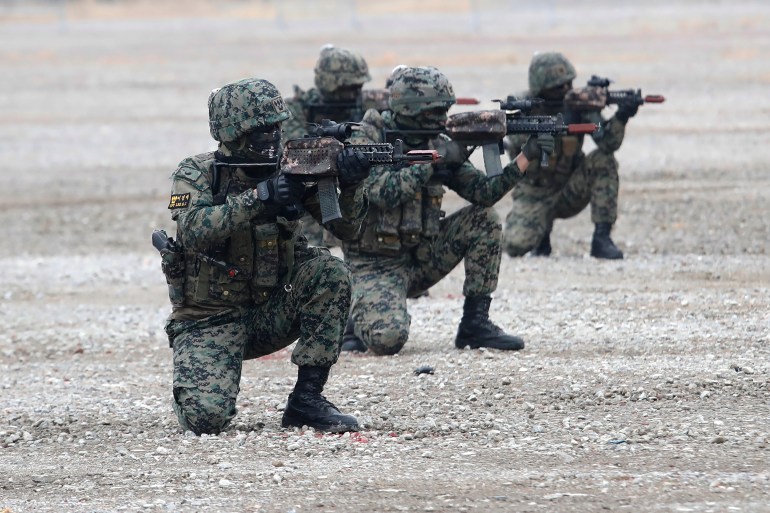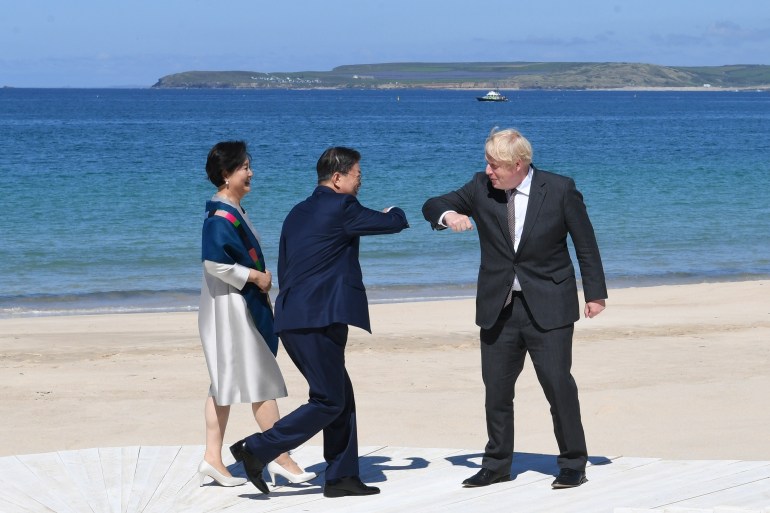Seoul courts risk after ‘no shackles’ missile development deal
South Korea can now develop missiles of whatever range and payload it wants, but analysts worry it could stoke tension.

Seoul, South Korea – South Korea is now free to develop missiles of whatever payload and range it chooses after an agreement last month between US President Joe Biden and South Korean President Moon Jae-in.
But the move, announced following the two leaders White House summit on May 21, introduced new security risks surrounding South Korea’s missile development and some analysts were concerned about the potential effect on the wider region.
Keep reading
list of 4 itemsNorth Korea accuses US of ‘double dealing’ over Seoul missiles
Biden meets Moon, appoints new US envoy for North Korea
‘Letters of truth’ from South to N Korea strain Moon’s diplomacy
The South Korean military already has cutting edge missile technology, although previously restricted to 800 kilometres (497 miles) in range, research fellow Daniel Bong, of the Yonsei Institute for North Korea Studies, told Al Jazeera. The question is whether the South Korean government wants to enter the exclusive club of states possessing long-range missiles.
“It’s one thing to have no shackles on missile development, but it’s another to go all the way at the risk of going in the wrong direction with China,” said Bong.
South Korea has gone in the wrong direction with China on missiles before, when it agreed to deploy Terminal High Altitude Area Defense (THAAD), a US missile defence system in 2017.
In response, Beijing imposed biting sanctions.
South Korean analysts affiliated with the government, as well as Moon administration officials, have suggested that China has an understanding of South Korea’s perspective on the missile guideline release, which Seoul has characterised as “regaining missile sovereignty”.
But the US missile plans could still spell trouble for South Korea.
In August 2019, the US withdrew from the Intermediate-Range Nuclear Forces Treaty with Russia. Later, former US Secretary of Defense Mark Esper suggested the US would be looking to deploy intermediate-range ballistic missiles, IRBMs, in the Asia Pacific region.
“South Korea could be the place, which would be a disaster when managing our relationship with neighbouring countries and, of course, China,” Senior Research Fellow Sung Ki-young, of the Institute for National Security Strategy, told Al Jazeera.

The key will be how far South Korea chooses to go with its missiles.
“By developing missiles with a longer range that can reach major cities inside China, South Korea will have less resistance to the deployment of US missiles that could target China,” said Yonsei’s Bong, before specifying, “I’m talking about nuclear missiles.”
Double standards
Some worry the free rein on missile development will drive China and North Korea closer together.
China’s Foreign Minister Wang Yi met North Korea’s ambassador to Beijing just after the Biden-Moon summit.
“They showed off their familial bonds … As the US-South Korea alliance strengthens, North Korea-China relations will strengthen, as well,” Seoul’s Peace Network director, Cheong Wook-sik, told Al Jazeera.
The missile guideline agreement also exposed the US to charges of hypocrisy, with its continued support of United Nations Security Council sanctions on North Korea.
“The US has significantly restricted, condemned, and imposed sanctions on North Korea’s missile development, so South Korea’s missile development shows a kind of double standard,” said Cheong.
Cheong believed it is just that kind of supposed double standard, coupled with resumed joint US-South Korea large-scale military exercises that could see the security atmosphere deteriorate.
“If the South Korea-US joint exercise is held this summer, North Korea may respond by resuming medium- and long-range missile tests,” said Cheong.
‘Stop playing with fire’
The relaxation of missile guidelines was one of several deals the Biden and Moon administrations concluded in May.

The US is also providing 550,000 South Korean troops with vaccines, ostensibly to protect the 28,500 members of the US forces who work alongside them, while Biden gave his backing for President Moon’s initiative to build peace with North Korea, despite Moon having just nine months left in office.
In return, Moon also edged closer to the US in relation to China: the joint statement “emphasize(d) the importance of preserving peace and stability in the Taiwan Strait.”
But some have suggested that what appeared to be equal trade-offs, actually offered the US more of a geopolitical advantage.
“The Moon Jae-in government was oversold by the Biden administration, which turned out to be skilled in negotiating, because the Moon Jae-in government appeared to be so desperate,” said Yonsei’s Bong.
President Moon is the third progressive South Korean leader of a line that has sought peace and unification on the Korean Peninsula, following Nobel Peace Prize laureate Kim Dae-jung, and President Roh Moo-hyun, under whom President Moon served as chief of staff.
In recent times, South Korea has tried to balance between Beijing and Washington.
Economically, Beijing holds sway. In 2003, it surpassed the US as South Korea’s largest trading partner and now accounts for more than a quarter of its exports, more than $125bn annually.
Meanwhile, it is the US, with its military bases and so-called “nuclear umbrella”, that guarantees South Korea’s security while China has become increasingly assertive, with frequent incursions into the Exclusive Economic Zones of South Korea, Taiwan and nations surrounding the South China Sea.
On the Taiwan Strait reference in the Biden-Moon joint statement, Beijing was quick to respond, its foreign ministry spokesman Zhao Lijian later telling a briefing, “relevant countries … should stop playing with fire.”
‘One less excuse’
On the missile guidelines, Beijing has so far been somewhat muted, and North Korea offered only a relatively moderate response: a state media article called the move “a stark reminder of the US hostile policy toward the DPRK and its shameful double-dealing.”
But analysts pointed to the implications of other elements of the Biden-Moon summit agreement, and the possible revival of joint military exercises that North Korea sees as a rehearsal for invasion.
South Korean peace activists have blamed the war games for inflaming tensions, and the Moon administration has sought to suspend the joint exercises – or at least tone them down – to generate goodwill with Pyongyang.
But at his confirmation hearing to become the commander of US Forces Korea, General Paul LeCamera said the joint US-South Korea military exercises were “extremely important to build readiness” and with the delivery of vaccines to South Korean and US forces, “the Moon Jae-in government is left with one less excuse to continuously suspend the annual joint military exercises with US forces in South Korea,” said Yonsei’s Bong.
Despite the challenges, some in the Moon administration are optimistic the Biden summit will lead to progress on North Korea peace building despite the South Korean president’s relative lame-duck status.

During their news briefing at the end of Moon’s White House visit, Biden referred to North Korea by its official name, the DPRK (the Democratic People’s Republic of Korea), and more significantly, Biden introduced a special envoy for North Korea, veteran US diplomat and negotiator, Sung Kim.
Moon himself suggested the appointment indicated US willingness to engage North Korea, later telling legislators, “the appointment of a US Special Envoy for the DPRK is equivalent to making a public request for North Korea to resume dialogue.”
Sung Kim is now scheduled to make his first trip to Seoul.
During the five day visit, which starts on Saturday, Kim is expected to meet his South Korean counterparts and engage in trilateral talks with Japanese representatives as well. That may prove awkward as Tokyo spurned a meeting with South Korean officials at the recent Group of Seven (G7) summit in Cornwall and the three countries have quite different perspectives about how to deal with North Korea.
The South Korean president has long favoured unconditional engagement, while the US and Japan advocate more hawkish strategies relying on continued sanctions.
As US-China rivalry intensifies, South Korea’s attempt to pursue its own project in regards to North Korea is likely to become ever more perilous.